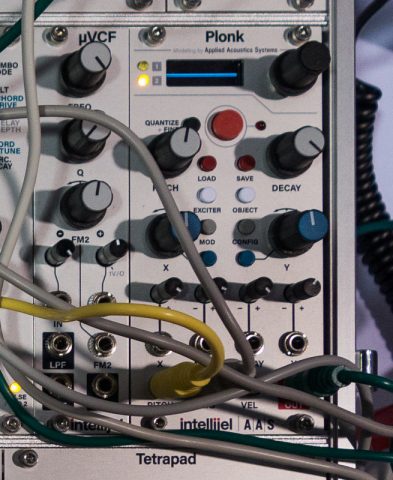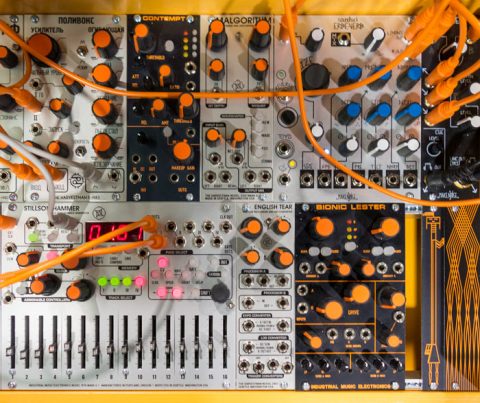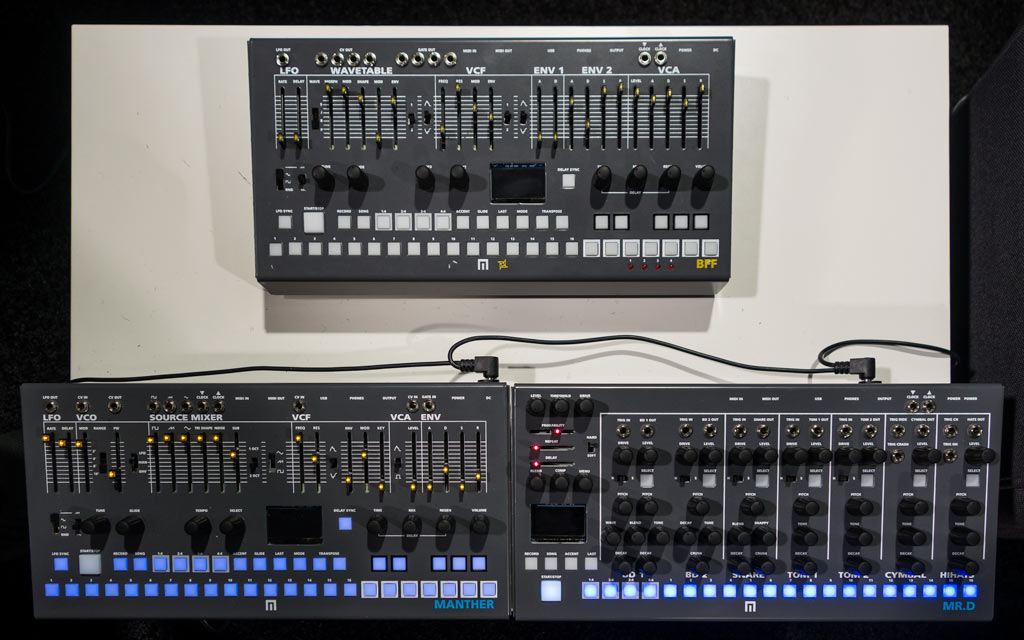My mildly insane idea of blogging everything modular of interest continues. Featured in this installment are a group of new modules from Intellijel, Industrial Music Electronics, and AJH Synth, as well as desktop synths (?!?) from Malekko including collaboration with Industrial Music Electronics.
Intellijel
 One of the most enjoyable new modules of the show for me is a collaboration between Intellijel and Applied Acoustic Systems (A|A|S) called Plonk ($309; 2nd quarter release): one of the most consistently musically useful struck-object physical modeling synths I’ve heard. This is A|A|S’s specialty, have created the software Tassman and Chromaphone. Intellijel has adapted their technology to hardware form, creating a two-voice module (so notes can overlap) running at 24 bits and 44.1 kHz. An exciter consisting of a mallet model and a shaped noise source feeds a resonator that can model strings, beams, plates, marimbas, membranes, and drumheads. Many similar modules I’ve played with have relatively narrow “sweet spots” in their control ranges, with the majority of the parameter ranges creating more odd, noisy sounds. I found Plonk to have a very fat sweet spot, quickly producing a wide range of very useable sounds – even when the randomizer is used to create new sounds. Normally I shy away from modules that have menus, but the combination of a very clear OLD display with several dedicated controls plus parameters that can be assigned by the user to X and Y knobs and control voltage inputs makes it much friendlier to use.
One of the most enjoyable new modules of the show for me is a collaboration between Intellijel and Applied Acoustic Systems (A|A|S) called Plonk ($309; 2nd quarter release): one of the most consistently musically useful struck-object physical modeling synths I’ve heard. This is A|A|S’s specialty, have created the software Tassman and Chromaphone. Intellijel has adapted their technology to hardware form, creating a two-voice module (so notes can overlap) running at 24 bits and 44.1 kHz. An exciter consisting of a mallet model and a shaped noise source feeds a resonator that can model strings, beams, plates, marimbas, membranes, and drumheads. Many similar modules I’ve played with have relatively narrow “sweet spots” in their control ranges, with the majority of the parameter ranges creating more odd, noisy sounds. I found Plonk to have a very fat sweet spot, quickly producing a wide range of very useable sounds – even when the randomizer is used to create new sounds. Normally I shy away from modules that have menus, but the combination of a very clear OLD display with several dedicated controls plus parameters that can be assigned by the user to X and Y knobs and control voltage inputs makes it much friendlier to use.
Another module getting a lot of attention is their Tetrapad ($299), which is a (relatively, for Eurorack) large two-dimensional touch controller that does not rely on capacitive touch – you can even be wearing gloves or use a stylus with it. It can sample the location of your touch with 12-bit precision. Tetrapad can run a variety of programs that change its personality, including using it as a set of four pressure sensitive virtual sliders, a chord generator with quantizer, strum mode and more.
A module that personally raised my eyebrows was Shifty ($159), which has several functions including as a sequential switch or analog shift register. After getting into ratcheting, I’ve been thinking lately about how to implement the old compositional trick known as hocketing where a monophonic melody line alternates which instruments plays it from note to note; Shifty would make that easy.
Intellijel also had several other very useful utility products, ranging from new cases (with padded travel bags) to a quad VCA to a 1U noise/random voltage/sample & hold module to a 1U $69 digital reverb based on a guitar pedal chip. And speaking of reverbs, they updated their Springray spring reverb module, shifting from a voltage based to current based design for the spring tank that they say greatly improves its performance.
AJH Synth
 This small company out of England originally made their mark by creating very high quality recreations of the building blocks that makes up a Minimoog, in Eurorack format. They’ve been branching out since then, including creating a very flexible ring modular and filter with waveshaper that I was swooning over last year, and recently they announced a new set of modules. These include:
This small company out of England originally made their mark by creating very high quality recreations of the building blocks that makes up a Minimoog, in Eurorack format. They’ve been branching out since then, including creating a very flexible ring modular and filter with waveshaper that I was swooning over last year, and recently they announced a new set of modules. These include:
- the V-Scale buffered mult that includes five outputs – four with trimmers on the front panel so you can tweak the tracking range of your oscillators (I recently wrote about some of the problems with multiples and oscillators; this is an excellent solution)
- a Dual LFO & VCA, which solves the problem of how do you use the control voltage from aftertouch or a mod wheel to create an LFO signal with depth that follows your controller (answer: you put the LFO through a DC-coupled VCA)
- a CV Mix-Offset-VCA utility module with four “attenuverting” channels summed into a VCA, including one channel with 2x gain
- an interesting DH-ADSR Envelope that is an ADSR with an initial delay stage, plus some flexible triggering modes including a Hold stage that keeps the envelope open for a fixed period of time to recreate EMS-style AHR envelopes
AJH Synth was one of several very interesting European companies creating high-quality modules that we don’t get to see much of in the US. The hope is that as more users learn about them, the more they’ll bug their favorite stores to carry them. I’ll be reporting on a few more including AOA, Birdkids, and Endorphin in upcoming installments.
Industrial Music Electronics

Catching the most interest was probably the one known as Contempt (~$300), a stereo dynamics processor with compressor and gate sections based on the SSM2164 chip. It’s envisioned as being a high-quality final output compressor for your rack. You can also patch in sidechain processing.
Fans of The Harvestman were gravitating toward the Bionic Lester Mark II (~$450-500). This is an update to their switched capacitance dual 2-pole multimode filter. The quirky switch capacitance design is driven by a very high frequency clock that is divided down to control a capacitor array. This clock tends to slew a bit as it chases changes in the cutoff frequency control voltage; there can also be anti-aliasing artifacts created by the capacitor section (this filter can be switched on or off in the Bionic Lester). The Mark II includes improvements such as an output mode mixer.

Malekko Heavy Industry
A tip of the hat to Malekko for having one of the most inclusive booths in the show (aside from the giant “WMD” booth which I’ll get to in future installments), hosting themselves as well as Industrial Music Electronics, Sputnik Modular, Erica Synths, LZX Industries, Modular Addict, Roland(!), and probably one or two others I’m missing.
The big surprise was that Malekko had three tabletop (rather than modular) units they were previewing. These included:
- the Manther ($599; a spring release is targeted) Curtis-chip-based monophonic analog synth based very loosely on the Roland SH1/2 models with serious enhancements including triangle and noise sources, a waveshaper for the triangle, and selectable sawtooth, square wave, or triangle wave for the subocatves. It includes a few external patch points, MIDI and USB, and a built-in step sequencer that can also control select synth parameters in addition to the normal pitch and gate. If I had to complain about something, it would be that a single ADSR is shared between the VCF and VCA (I’m personally a big fan of at least an AD for the VCF and a separate AR for the VCA), but it does have a “gate” envelope option for the VCA. The software can be update over USB, so we may see additional functionality such as an arpeggiator in the future.
- the Mr.D analog drum machine (also targeted for $599 this spring), which I’m told will have a bias toward “crunchy” sounds. It contains two kick and two toms among its arsenal. There is a mix output as well as separate outputs per sound (the open and closed hihats are on out output); plugging into a direct output pulls that sound out of the mix. It has a built-in drum sequencer, with the equivalent of the Varigate trigger magic on each drum channel. Interestingly, each drum channel has a trigger input; plugging into that jack disables the sequencer for that sound. Yes, there is MIDI and USB on this one too.
- BFF ($650, later 2017) which is a digital/analog hybrid 4-voice synth that uses a digital oscillator designed by Industrial Music Electronics and again Curtis analog chips (such as a clone of the CEM 3320 filter) to process it. The digital section includes 16 different waveforms with morphing, a second oscillator per voice that can be detuned, and the waveshaper section from The Harvestman’s Piston Honda.
Unfortunately none of these machines were quite ready to be auditioned at the show; I expect the sound of each to be a bit out of the box (if you excuse the pun). Several were also asking about their new Eurorack cases, which were previewed a year ago at NAMM; they’re getting closer, with the 12 U case probably shipping this spring and the 6U model later this year. The pricing is still not set (maybe very roughly $1000 for the 12U? remember that it has over $500 of Malekko power supplies in it…) and the hardware is still being tweaked; I liked that it opened at slight angle making it easier to view while standing in front of it.
Okay – time for sleep before tackling the show floor one last day. And that doesn’t count the nearly 20 booths I visited and chatted at Friday and Saturday. More to come…


